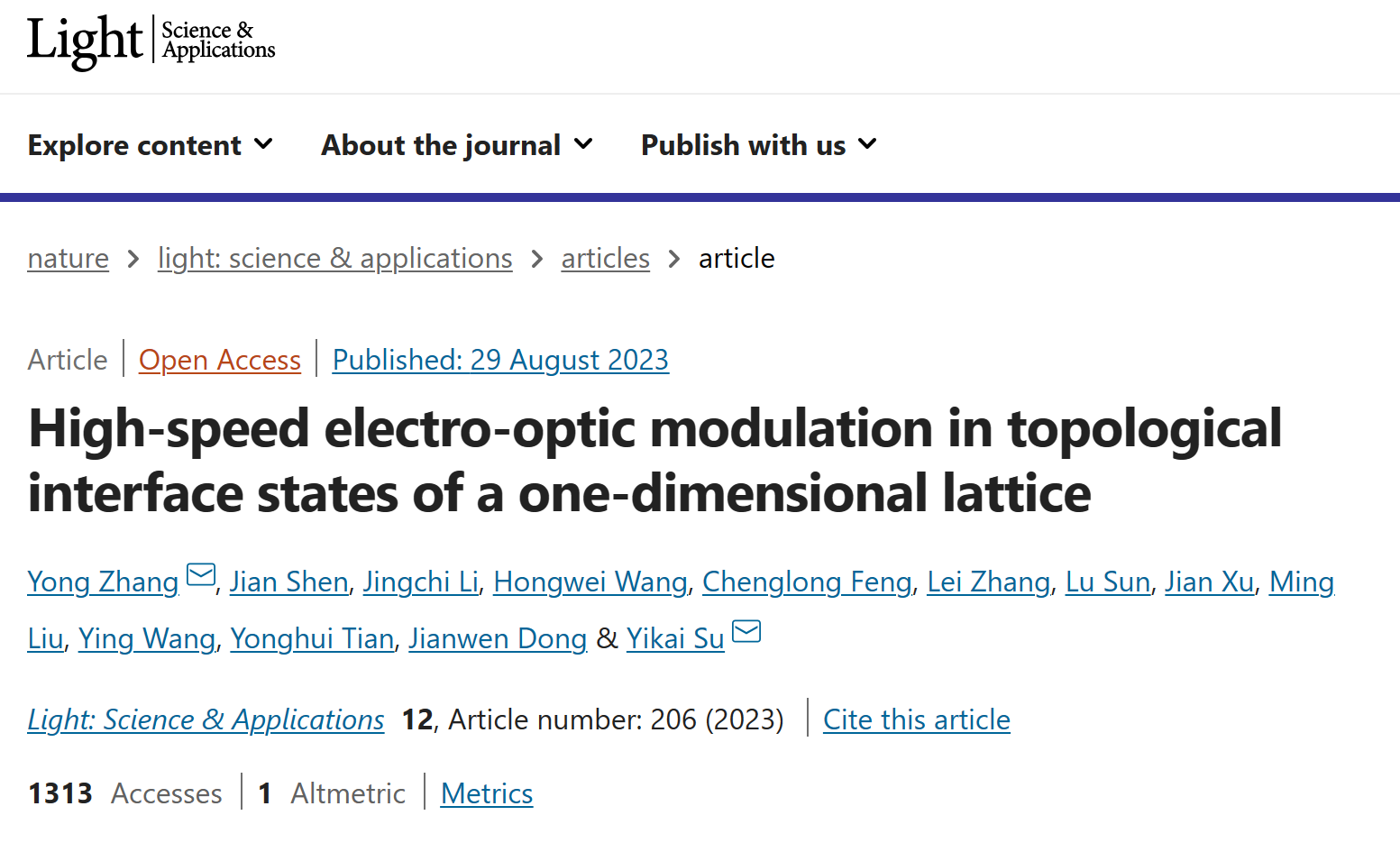- Home
- About Us
- Students
- Academics
-
Faculty
- Electrical Engineering
- Automation
- Computer Science & Engineering
- Electronic Engineering
- Instrument Science and Engineering
- Micro-Nano Electronics
- School of Software
- Academy of Information Technology and Electrical Engineering
- School of Cyber Security
- Electrical and Electronic Experimental Teaching Center
- Center for Advanced Electronic Materials and Devices
- Cooperative Medianet Innovation Center
- Alumni
-
Positions
-
Forum
News
- · Bin Dai's Team Unveils the Assembly Mechanism of β-Lactoglobulin Fibrils, Providing New Insights for the Development of Functional Nanomaterials
- · Mingyi Chen’s research group has made important progress in the field of analog-to-digital converter chips for brain-computer interface
- · Progress in the Development of Semiconductor Nanomaterials to Activate Pyroptosis for Cancer Therapy
- · Jiamiao Yang’s team achieved the high precision optoelectronic reservoir computing based on complex-value encoding
- · Significant Advancements in Resonator-Enhanced Quantum Sensing Achieved by Zenguihua's Team at the School of Sensing Science and Engineering
Researchers from the Department of Electronic Engineering at Shanghai Jiao Tong University, led by Yong Zhang and Yikai Su, have made significant progress in the development of high-speed electro-optic modulation in topological interface states of a one-dimensional lattice
Recently, Professor Yikai Su research team at Shanghai Jiao Tong University, along with Associate Researcher Yong Zhang, collaborated with Professor Yonghui Tian from Lanzhou University and Professor Jianwen Dong from Sun Yat-sen University. They proposed a compact, low-power-consumption, and wide-bandwidth high-speed electro-optic modulator based on the principle of generating one-dimensional topological edge state modes on a lithium niobate platform loaded with silicon nitride film. Benefitting from the strong confinement and robustness of the one-dimensional topological lattice waveguide, the length of the topological photonic microcavity is short, and it strictly maintains single-mode operation, avoiding the issue of multi-mode control. The achievement, entitled "High-speed electro-optic modulation in topological interface states of a one-dimensional lattice," has been published in the internationally renowned optical journal "Light: Science & Applications". Shanghai Jiao Tong University is the first institution, with Associate Researcher Yong Zhang as the first author. Yong Zhang and Yikai Su are corresponding authors. Professor Yonghui Tian and Professor Jianwen Dong provide valuable advice and guidance for this research, and the Advanced Electronic Materials and Devices (AEMD) Platform of Shanghai Jiao Tong University provides crucial process support. This work was supported by the Key Technologies Research and Development Program and the National Natural Science Foundation of China (Key Program/Fund).

Figure 1
Background
Electro-optic modulators can convert electrical signals into optical signals and serve as core devices in optical communication, terahertz wireless communication, microwave signal processing, and quantum technology. The next-generation electro-optic modulators need to possess characteristics such as small size, large bandwidth, low power consumption, and high-density integration. Existing electro-optic modulators based on Mach-Zehnder interferometers or microcavity structures remain challenge.
Topological photonics show characteristics of suppressing backward scattering, strong optical confinement, and robustness against defects in optical transmission. In recent years, topological photonics have attracted much attention and have been utilized to realize various high-performance integrated optoelectronic devices, such as nonlinear devices, and quantum devices. Currently, most topological photonics devices exhibit slow response times on the order of microseconds, and high-speed topological modulators have hardly been explored. Combining topological edge states with thin-film lithium niobate provides the potential to significantly accelerate the response time of topological devices, addressing the challenges in the next-generation electro-optic modulators.
Innovative results
In response to the advantages of topological photonics and the existing issues with conventional electro-optic modulators, the research team investigate the phase variation of topological edge states based on one-dimensional topological photonic crystal, and then map this phase variation onto a one-dimensional topological photonic lattice waveguide deposited on a silicon-nitride-loaded lithium-niobate-on-insulator platform, as shown in Figure 2.

Figure 2 Schematic diagram of a high-speed electro-optic modulator based on one-dimensional topological lattice
As shown in Figure 3 (a) ~ (h), the research team calculate the Zak phase and topological invariant signs of the left and right topological photonic crystals based on the Su-Schrieffer-Heeger (SSH) model. When the signs of these invariants are opposite, topological edge states are obtained in the middle of the bandgap. To take advantage of the short length and the strong optical confinement of the topological cavity, the researchers prepare metal electrodes on both sides of the one-dimensional topological lattice waveguide on a silicon-nitride-loaded lithium-niobate-on-insulator platform, which enables the achievement of a high-speed electro-optic modulation with large bandwidth and low power consumption on the topological edge states. Microscope images and scanning electron microscope (SEM) images of the device are shown in Figure 3 (i) ~ (k). The modulator has a footprint of 1.6 × 140 μm2, and the measured tuning efficiency of the resonance wavelength is 11 pm/V. By the peak enhancement effect of the topological cavity, the modulator achieves a modulation bandwidth of up to 104 GHz, breaking the photon lifetime limitation. To further demonstrate the high-speed data modulation performance, the research team conduct on-chip high-speed data modulation transmission experiments. The experimental results indicate that the fabricated modulator can support transmission of non-return-to-zero (NRZ) signals and four-level pulse amplitude modulation (PAM4) signals with up to 100 Gbps. The bit error rate (BER) is lower than 7% with a hard decision forward error correction (HD-FEC) threshold of 3.8 × 10-3.

Figure 3 Basic principles and applications of topological phase transitions. (a, b, c, d) Simulation of the band structure of one-dimensional topological photonic crystal in the dielectric layer and calculation of its Zak phase. (e, f, g, h) Simulation of the band structure of one-dimensional topological photonic lattice waveguide based on a silicon-nitride-loaded lithium-niobate-on-insulator platform. (i, j, k) Optical microscope images and scanning electron microscope (SEM) photos of the fabricated devices.
By the research on high-speed electro-optic modulation based on topological edge states, the researchers have discovered that ultra-compact topological cavities offer strong optical confinement and robustness compared to traditional waveguide structures. These topological cavities are not only smaller in size but also allow flexible control of the Q factor and mode volume while strictly maintaining single-mode operation, avoiding mode control. In conclusion, the modulator exhibits outstanding performance in terms of size, bandwidth, speed, and energy consumption, providing significant potential for high-speed modulation in fully integrated thin-film lithium niobate photonics. The researchers improve the response time of topological devices to the picosecond range, advancing the application of topological integrated devices in fields such as optical communication, microwave photonics, and quantum information processing.
Paper information
Main author of the paper:
Yong Zhang(Associate Professor, Shanghai Jiao Tong University)、Jian Shen(Ph.D Student, Shanghai Jiao Tong University)、Jingchi Li(Postdoc, Shanghai Jiao Tong University)、Hongwei Wang(Postdoc, Shanghai Jiao Tong University)、Yonghui Tian(Professor, Lanzhou University)、Jianwen Dong(Professor, Sun Yat-sen University)、Yikai Su(Professor, Shanghai Jiao Tong University)

Figure 4
Link to paper:
https://www.nature.com/articles/s41377-023-01251-x
Journal information:
The journal "Light: Science & Applications" was launched on March 29, 2012, and is an international optical science academic journal published in English and available in open access. It is published in collaboration between the Changchun Institute of Optics, Fine Mechanics and Physics (CIOMP) of the Chinese Academy of Sciences and the Nature Publishing Group (NPG) from the United Kingdom. It was indexed in international databases, including SCI and Scopus, in October 2013. In 2022-2023, it has an impact factor of 19.4.
-
Students
-
Faculty/Staff
-
Alumni
-
Vistors
-
Quick Links
